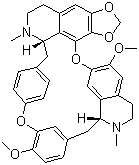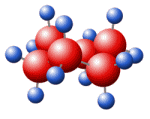|
|
|

|
Suppliers for
Cepharanthine
|
Properties | | CAS |
481-49-2 | | Formula |
C37H38N2O6 |

|
|
13 Registered suppliers
Molecular Formula : C37H38N2O6
Molecular Formula : C37H38N2O6
Molecular Formula : C37H38N2O6
Molecular Formula : C37H38N2O6
Molecular Formula: C37H38N2O6
Molecular Weight: 606.71
Molecular Formula: C37H38N2O6
Molecular Weight: 606.71
More details are to be found here
More details are to be found here
Description : Cepharanthine (CEP) is a biscoclaurine alkaloid isolated from Stephania cepharantha. It has anticancer, antiinflammatory, antiallergic, immunomo- dulatory, and many other interesting biological activities. Cepharanthine has been widely used in Japan for more than 40 years to treat a wide variety of acute and chronic diseases. CEP inhibits tumor necrosis factor (TNF)-α-mediated NFκB stimulation, plasma membrane lipid peroxidation and platelet aggregation and suppresses cytokine production. It has also been shown to scavenge free radicals and to have a protective effect against some of the responses mediated by pro-inflammatory cytokines such as TNF-α, interleukin (IL)-1β and IL6. CEP has successfully been used to treat a diverse range of medical conditions, including radiation-induced leukopenia, idiopathic thrombocytopenic purpura, alopecia areata, alopecia pityrodes, venomous snakebites, xerostomia, sarcoidosis, refractory anemia and various cancer-related conditions. No safety issues have been observed with CEP, and side effects are very rarely reported. - Molecular Weight :606.71
- Melting Point :170-175°C
- Purity :> 98%
Molecular Formula : C37H38N2O6 Canonical SMILES : CN1CCC2=CC3=C(C4=C2C1CC5=CC=C(C=C5)OC6=C(C=CC(=C6)CC7C8=CC(=C(C=C8CCN7C)OC)O4)OC)OCO3
InChI :
InChI=1S/C37H38N2O6/c1-38-13-11-24-18-31(41-4)33-20-27(24)28(38)16-23-7-10-30(40-3)32(17-23)44-26-8-5-22(6-9-26)15-29-35-25(12-14-39(29)2)19-34-36(37(35)45-33)43-21-42-34/h5-10,17-20,28-29H,11-16,21H2,1-4H3/t28-,29+/m1/s1
InChIKey :
YVPXVXANRNDGTA-WDYNHAJCSA-N
Solubility :
Soluble in Chloroform (Sparingly), DMSO (Slightly), Methanol (Slightly)
Appearance :
Off-white to Light Yellow Solid
Application :
Anti-tumor/anti-inflammatory
Storage : Store at 2-8°C
Synonyms :
Cepharanthin; NSC-623442; 6',12'-Dimethoxy-2,2'-dimethyl-6,7-(methylenebis(oxy))oxyacanthan; (+)-Cepharanthine; O-Methylcepharanoline; Cepharantin; [14aS-(14aR*,26aS*)]-2,3,13,14,14a,15,26,26a-Octahydro-22,30-dimethoxy-1,14-dimethyl-1H-4,6:16,19-dietheno-21,25-metheno-12H-[1,3]dioxolo[4,5-g]pyrido[2',3':17,18][1,10]dioxacycloeicosino[2,3,4-ij]isoquinoline
More details are to be found here
Description : Cepharanthine (CEP) is a biscoclaurine alkaloid isolated from Stephania cepharantha. It has anticancer, antiinflammatory, antiallergic, immunomo- dulatory, and many other interesting biological activities. Cepharanthine has been widely used in Japan for more than 40 years to treat a wide variety of acute and chronic diseases. CEP inhibits tumor necrosis factor (TNF)-α-mediated NFκB stimulation, plasma membrane lipid peroxidation and platelet aggregation and suppresses cytokine production. It has also been shown to scavenge free radicals and to have a protective effect against some of the responses mediated by pro-inflammatory cytokines such as TNF-α, interleukin (IL)-1β and IL6. CEP has successfully been used to treat a diverse range of medical conditions, including radiation-induced leukopenia, idiopathic thrombocytopenic purpura, alopecia areata, alopecia pityrodes, venomous snakebites, xerostomia, sarcoidosis, refractory anemia and various cancer-related conditions. No safety issues have been observed with CEP, and side effects are very rarely reported. - Molecular Weight :606.71
- Melting Point :170-175°C
- Purity :> 98%
Molecular Formula : C37H38N2O6 Canonical SMILES : CN1CCC2=CC3=C(C4=C2C1CC5=CC=C(C=C5)OC6=C(C=CC(=C6)CC7C8=CC(=C(C=C8CCN7C)OC)O4)OC)OCO3
InChI :
InChI=1S/C37H38N2O6/c1-38-13-11-24-18-31(41-4)33-20-27(24)28(38)16-23-7-10-30(40-3)32(17-23)44-26-8-5-22(6-9-26)15-29-35-25(12-14-39(29)2)19-34-36(37(35)45-33)43-21-42-34/h5-10,17-20,28-29H,11-16,21H2,1-4H3/t28-,29+/m1/s1
InChIKey :
YVPXVXANRNDGTA-WDYNHAJCSA-N
Solubility :
Soluble in Chloroform (Sparingly), DMSO (Slightly), Methanol (Slightly)
Appearance :
Off-white to Light Yellow Solid
Application :
Anti-tumor/anti-inflammatory
Storage : Store at 2-8°C
Synonyms :
Cepharanthin; NSC-623442; 6',12'-Dimethoxy-2,2'-dimethyl-6,7-(methylenebis(oxy))oxyacanthan; (+)-Cepharanthine; O-Methylcepharanoline; Cepharantin; [14aS-(14aR*,26aS*)]-2,3,13,14,14a,15,26,26a-Octahydro-22,30-dimethoxy-1,14-dimethyl-1H-4,6:16,19-dietheno-21,25-metheno-12H-[1,3]dioxolo[4,5-g]pyrido[2',3':17,18][1,10]dioxacycloeicosino[2,3,4-ij]isoquinoline
More details are to be found here
Description : Cepharanthine (CEP) is a biscoclaurine alkaloid isolated from Stephania cepharantha. It has anticancer, antiinflammatory, antiallergic, immunomo- dulatory, and many other interesting biological activities. Cepharanthine has been widely used in Japan for more than 40 years to treat a wide variety of acute and chronic diseases. CEP inhibits tumor necrosis factor (TNF)-α-mediated NFκB stimulation, plasma membrane lipid peroxidation and platelet aggregation and suppresses cytokine production. It has also been shown to scavenge free radicals and to have a protective effect against some of the responses mediated by pro-inflammatory cytokines such as TNF-α, interleukin (IL)-1β and IL6. CEP has successfully been used to treat a diverse range of medical conditions, including radiation-induced leukopenia, idiopathic thrombocytopenic purpura, alopecia areata, alopecia pityrodes, venomous snakebites, xerostomia, sarcoidosis, refractory anemia and various cancer-related conditions. No safety issues have been observed with CEP, and side effects are very rarely reported. - Molecular Weight :606.71
- Melting Point :170-175°C
- Purity :> 98%
Molecular Formula : C37H38N2O6 Canonical SMILES : CN1CCC2=CC3=C(C4=C2C1CC5=CC=C(C=C5)OC6=C(C=CC(=C6)CC7C8=CC(=C(C=C8CCN7C)OC)O4)OC)OCO3
InChI :
InChI=1S/C37H38N2O6/c1-38-13-11-24-18-31(41-4)33-20-27(24)28(38)16-23-7-10-30(40-3)32(17-23)44-26-8-5-22(6-9-26)15-29-35-25(12-14-39(29)2)19-34-36(37(35)45-33)43-21-42-34/h5-10,17-20,28-29H,11-16,21H2,1-4H3/t28-,29+/m1/s1
InChIKey :
YVPXVXANRNDGTA-WDYNHAJCSA-N
Solubility :
Soluble in Chloroform (Sparingly), DMSO (Slightly), Methanol (Slightly)
Appearance :
Off-white to Light Yellow Solid
Application :
Anti-tumor/anti-inflammatory
Storage : Store at 2-8°C
Synonyms :
Cepharanthin; NSC-623442; 6',12'-Dimethoxy-2,2'-dimethyl-6,7-(methylenebis(oxy))oxyacanthan; (+)-Cepharanthine; O-Methylcepharanoline; Cepharantin; [14aS-(14aR*,26aS*)]-2,3,13,14,14a,15,26,26a-Octahydro-22,30-dimethoxy-1,14-dimethyl-1H-4,6:16,19-dietheno-21,25-metheno-12H-[1,3]dioxolo[4,5-g]pyrido[2',3':17,18][1,10]dioxacycloeicosino[2,3,4-ij]isoquinoline
More details are to be found here
Description : Cepharanthine (CEP) is a biscoclaurine alkaloid isolated from Stephania cepharantha. It has anticancer, antiinflammatory, antiallergic, immunomo- dulatory, and many other interesting biological activities. Cepharanthine has been widely used in Japan for more than 40 years to treat a wide variety of acute and chronic diseases. CEP inhibits tumor necrosis factor (TNF)-α-mediated NFκB stimulation, plasma membrane lipid peroxidation and platelet aggregation and suppresses cytokine production. It has also been shown to scavenge free radicals and to have a protective effect against some of the responses mediated by pro-inflammatory cytokines such as TNF-α, interleukin (IL)-1β and IL6. CEP has successfully been used to treat a diverse range of medical conditions, including radiation-induced leukopenia, idiopathic thrombocytopenic purpura, alopecia areata, alopecia pityrodes, venomous snakebites, xerostomia, sarcoidosis, refractory anemia and various cancer-related conditions. No safety issues have been observed with CEP, and side effects are very rarely reported. - Molecular Weight :606.71
- Melting Point :170-175°C
- Purity :> 98%
Molecular Formula : C37H38N2O6 Canonical SMILES : CN1CCC2=CC3=C(C4=C2C1CC5=CC=C(C=C5)OC6=C(C=CC(=C6)CC7C8=CC(=C(C=C8CCN7C)OC)O4)OC)OCO3
InChI :
InChI=1S/C37H38N2O6/c1-38-13-11-24-18-31(41-4)33-20-27(24)28(38)16-23-7-10-30(40-3)32(17-23)44-26-8-5-22(6-9-26)15-29-35-25(12-14-39(29)2)19-34-36(37(35)45-33)43-21-42-34/h5-10,17-20,28-29H,11-16,21H2,1-4H3/t28-,29+/m1/s1
InChIKey :
YVPXVXANRNDGTA-WDYNHAJCSA-N
Solubility :
Soluble in Chloroform (Sparingly), DMSO (Slightly), Methanol (Slightly)
Appearance :
Off-white to Light Yellow Solid
Application :
Anti-tumor/anti-inflammatory
Storage : Store at 2-8°C
Synonyms :
Cepharanthin; NSC-623442; 6',12'-Dimethoxy-2,2'-dimethyl-6,7-(methylenebis(oxy))oxyacanthan; (+)-Cepharanthine; O-Methylcepharanoline; Cepharantin; [14aS-(14aR*,26aS*)]-2,3,13,14,14a,15,26,26a-Octahydro-22,30-dimethoxy-1,14-dimethyl-1H-4,6:16,19-dietheno-21,25-metheno-12H-[1,3]dioxolo[4,5-g]pyrido[2',3':17,18][1,10]dioxacycloeicosino[2,3,4-ij]isoquinoline
More details are to be found here
Description : Cepharanthine (CEP) is a biscoclaurine alkaloid isolated from Stephania cepharantha. It has anticancer, antiinflammatory, antiallergic, immunomo- dulatory, and many other interesting biological activities. Cepharanthine has been widely used in Japan for more than 40 years to treat a wide variety of acute and chronic diseases. CEP inhibits tumor necrosis factor (TNF)-α-mediated NFκB stimulation, plasma membrane lipid peroxidation and platelet aggregation and suppresses cytokine production. It has also been shown to scavenge free radicals and to have a protective effect against some of the responses mediated by pro-inflammatory cytokines such as TNF-α, interleukin (IL)-1β and IL6. CEP has successfully been used to treat a diverse range of medical conditions, including radiation-induced leukopenia, idiopathic thrombocytopenic purpura, alopecia areata, alopecia pityrodes, venomous snakebites, xerostomia, sarcoidosis, refractory anemia and various cancer-related conditions. No safety issues have been observed with CEP, and side effects are very rarely reported. - Molecular Weight :606.71
- Melting Point :170-175°C
- Purity :> 98%
Molecular Formula : C37H38N2O6 Canonical SMILES : CN1CCC2=CC3=C(C4=C2C1CC5=CC=C(C=C5)OC6=C(C=CC(=C6)CC7C8=CC(=C(C=C8CCN7C)OC)O4)OC)OCO3
InChI :
InChI=1S/C37H38N2O6/c1-38-13-11-24-18-31(41-4)33-20-27(24)28(38)16-23-7-10-30(40-3)32(17-23)44-26-8-5-22(6-9-26)15-29-35-25(12-14-39(29)2)19-34-36(37(35)45-33)43-21-42-34/h5-10,17-20,28-29H,11-16,21H2,1-4H3/t28-,29+/m1/s1
InChIKey :
YVPXVXANRNDGTA-WDYNHAJCSA-N
Solubility :
Soluble in Chloroform (Sparingly), DMSO (Slightly), Methanol (Slightly)
Appearance :
Off-white to Light Yellow Solid
Application :
Anti-tumor/anti-inflammatory
Storage : Store at 2-8°C
Synonyms :
Cepharanthin; NSC-623442; 6',12'-Dimethoxy-2,2'-dimethyl-6,7-(methylenebis(oxy))oxyacanthan; (+)-Cepharanthine; O-Methylcepharanoline; Cepharantin; [14aS-(14aR*,26aS*)]-2,3,13,14,14a,15,26,26a-Octahydro-22,30-dimethoxy-1,14-dimethyl-1H-4,6:16,19-dietheno-21,25-metheno-12H-[1,3]dioxolo[4,5-g]pyrido[2',3':17,18][1,10]dioxacycloeicosino[2,3,4-ij]isoquinoline
More details are to be found here
|
Properties:
... more properties and specification on Cepharanthine
|
|
Privileged suppliers
Last update 2024-04-24
|



 details
details details
details
_Co_Ltd_1_575.jpg)







